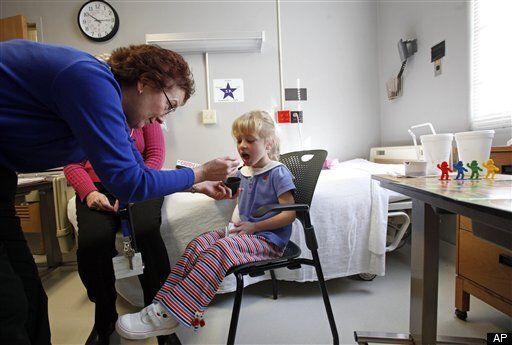
Children with Atopic Dermatitis have skin that becomes red, scaly or flaky and very itchy in response to irritants. These irritants can include foods as well as environmental factors, like certain fabrics or even cigarette smoke. It appears that food allergies can contribute to Atopic Dermatitis, although we know that they are not the cause of the condition. About 80 percent of those who develop Atopic Dermatitis show their first symptoms before they turn five, which makes managing the condition a real concern for parents.
The best way to diagnose food allergies is with the scratch test: the extract of a possible allergen is applied to the skin and then the skin is pricked or scratched to introduce the allergen into the body. If the skin reacts to the scratch in a certain way, it's considered a good indication that the person is allergic to that allergen. Now that it is possible to perform blood tests for certain allergen antibodies, these blood tests are even more often used to diagnose food allergies than scratch tests.
The problem, however, is that scratch tests and blood tests are considered to be conclusive evidence of an allergy only for cow's milk, hen's eggs, fish, peanuts and tree nuts. A gluten allergy diagnosis, for example, is only considered conclusive after a biopsy of the small intestine -- antibodies are indicative but not conclusive. However, the most conclusive test for all other food allergies is quite simple: Can the food be eaten without triggering an immediate, clinical reaction?
Researchers from the pediatric departments of the National Jewish Health center in Denver along with the University of Colorado became concerned after noting that more and more children were being diagnosed with food allergies. With the best of intentions, parents were following their doctors' instructions and removing foods from their childrens' diets, in some cases leading to malnutrition and poor weight gain in the children. What if the diagnosis of a food allergy was incorrect and the children could eat those foods?
The researchers reviewed the charts of 125 children who had been avoiding a particular food due to an allergy that had been diagnosed through a blood test but then underwent an Oral Food Challenge (actually ate the food under controlled conditions). All of the children had Atopic Dermatitis and 96 percent of them had active symptoms at the time of the test -- many of them considered severe.
The children had been diagnosed with allergies to many common foods, from milk to vegetables to soy. After the Oral Food Challenge, at least 77 percent of the children were found to not be allergic to the food being tested.
If you or your children have Atopic Dermatitis and are avoiding foods based on a blood test alone, discuss taking an Oral Food Challenge with your physician. You may be avoiding a food for no reason.